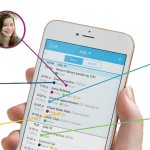

“An innovative new app might provide a more effective form of birth control than the contraceptive pill,” The Sun reports.
The Natural Cycles fertility app combines the use of a thermometer to measure body temperature with calendar calculating methods – often referred to as the rhythm method – to work out the days when a woman would be at high or low risk of pregnancy.
More than 4,000 women were included in this Swedish study looking at how effective the app is at preventing pregnancy.
A total of 143 unplanned pregnancies occurred during the study period, 10 of which were the result of the app falsely indicating a safe day.
Data collected by the app was used to work out that, if used exactly as advised, 5 women out of every 1,000 will accidentally become pregnant, and 7 out of every 100 women will become pregnant for “typical use” (not using the app correctly), each year.
This app may be attractive for women who are unwilling to use other forms of contraception, possibly for religious or cultural reasons, or because they have concerns about the side effects of hormonal contraception.
This app may also help indicate the best days to try to conceive.
But an obvious disadvantage of this contraceptive method is that the app does not protect against sexually transmitted infections in the same way as a condom.
Further research weighing an app like this against established contraceptive methods would be required to confirm whether its effectiveness is comparable.
Contents
Where did the story come from?
The study was carried out by researchers from the manufacturer of the application, Natural Cycles Nordic AB, along with the Karolinska Institutet and University Hospital, Stockholm.
Funding was provided by Natural Cycles Nordic AB.
There is a conflict of interest with this study, as the lead authors, Elina Scherwitzl and Raoul Scherwitzl, created the app and founded the company with stock ownership, while another author, Jonas Sellberg is employed by Natural Cycles Nordic AB.
The study was published in the peer-reviewed European Journal of Contraception and Reproductive Health Care.
It has been reported on accurately in the media, with statistical comparisons made between the effectiveness of the app and the effectiveness of the contraceptive pill.
The Daily Telegraph quoted the app’s creators, who said: “The algorithm behind the app learns about each individual woman’s temperature fluctuations over time, so becomes more accurate as you use it more frequently.”
They went on to say: “You say what your goal is when you start the app, so if you are planning a pregnancy rather than preventing, we identify the most fertile days and flag if you need to see a fertility specialist.”
What kind of research was this?
This was a retrospective data analysis study that aimed to evaluate the effectiveness of a fertility awareness-based method, supported by a mobile-based application, to prevent unwanted pregnancies as a method of natural birth control.
Retrospective studies are flawed in that the data collected was not intended for such analyses and may not always give an accurate representation.
What did the research involve?
The researchers included data from fertile women aged 18 to 45 who were using a mobile-based application, Natural Cycles, as a contraceptive method. Subscription to the service, including a thermometer, cost €50.
Women included in the analysis had to meet certain criteria. They had to have:
- accessed the app for at least three months during the study
- entered data for a total of at least 20 days
- not planned a pregnancy during the study period
At the beginning of the study women filled out a questionnaire related to their cycle, previous contraceptive use, height and weight. An additional optional questionnaire was sent via email three weeks before the end of the study.
Women entered their date of menstruation and body temperature recordings into the app until the end of the study, or until they dropped out because they were pregnant or had stopped using the method.
The data entered was then processed by the app to compute red (unsafe) or green (safe) days to indicate the risk of getting pregnant. The app considered the different phases of a woman’s cycle and the associated changes in body temperature when computing risk.
Evaluation of the app as a contraceptive method was determined by the number of pregnancies identified from a positive pregnancy test result being entered, the algorithm detecting a pregnancy, or the online questionnaire.
All users considered potentially pregnant by the algorithm were classified as pregnant in this study, even if they failed to confirm with a pregnancy test, as requested by the app, to provide the most conservative estimates.
Cases were considered unknown if it was not possible to detect a pregnancy with any of these methods. If a green day had been given within the fertile phase of a cycle where a woman had become pregnant, this was considered a failure.
Data collected was used to work out a Pearl Index, a measure of contraceptive effectiveness. A high Pearl Index means there is a high chance of unintentionally getting pregnant, while a low value means there is a low chance.
What were the basic results?
A total of 4,054 women tested the app, and 483,221 daily entries were analysed. The drop-out rate before the end of the study was high, at 1,397 women (34%).
The number of identified unplanned pregnancies was 143. Of these, 123 were positive test entries into the app, while 15 were detected with the algorithm and 5 were found through the survey.
Ten of the pregnancies were because the app falsely attributed a safe day within the fertile window. This indicates that if used correctly all the time, the application has a Pearl Index of 0.5, meaning 5 women out of every 1,000 will accidentally become pregnant each year.
For “typical use” – where the app is not used correctly – the Pearl Index was 7, which means that 7 out of every 100 women will experience accidental pregnancies each year.
The most conservative estimate, attributing a pregnant outcome to all 61 women for whom the pregnancy outcome was not known, gave a Pearl Index of 9.8 – 10 women out of every 100 each year.
Half of the pregnant women (51%) had logged unprotected sex during the fertile phase.
How did the researchers interpret the results?
The researchers concluded: “The application appears to improve the effectiveness of fertility awareness-based methods and can be used to prevent pregnancies if couples consistently protect themselves on fertile days.”
Conclusion
This was a retrospective data analysis study that aimed to evaluate the effectiveness of a mobile-based app to prevent unwanted pregnancies as a method of natural birth control.
The app used data entered by the women to work out days when there was a high or low risk of becoming pregnant in the absence of hormonal or barrier contraception.
The app was calculated to have a Pearl Index of 0.5, meaning 5 women out of every 1,000 will accidentally become pregnant each year. The Pearl Index was 7 for typical use, which means 7 out of every 100 women will experience accidental pregnancies each year.
Natural methods of contraception are popular for those who do want to use other methods of contraception. An app like this helps to keep track of which days are risky and when it would be better to abstain from unprotected sex.
But this study does have limitations. The retrospective design means data was not collected to specifically answer this question and may not be fit for purpose.
Most of the women in the study were aged 20 to 35, and therefore the findings may not apply to other age groups.
The participants in this study purchased membership and were obviously keen to try this method. Their usage may not be a true indication of the effectiveness of this type of app if it was available for free.
Even here, where the app was purchased, a third of the women stopped using it, which is a much higher drop-out rate than other methods, such as the contraceptive pill. Reasons for stopping using the app were not provided in the study write-up.
In addition to helping women to avoid becoming pregnant, this app might also help indicate the best days to try to conceive. The authors mention that these days are underestimated by the app, but it may still help, provided women remember to enter details correctly.
A head-to-head randomised trial comparing such an app with established contraceptive methods would be required to establish how effective it is as a method of birth control, and would also be a better design to find out whether an app can replace the pill, as the headlines have stated.
However effective an application may be, it will not protect you against sexually transmitted infections, unlike the low-tech – but very reliable –condom.
[Source:- NHS]




